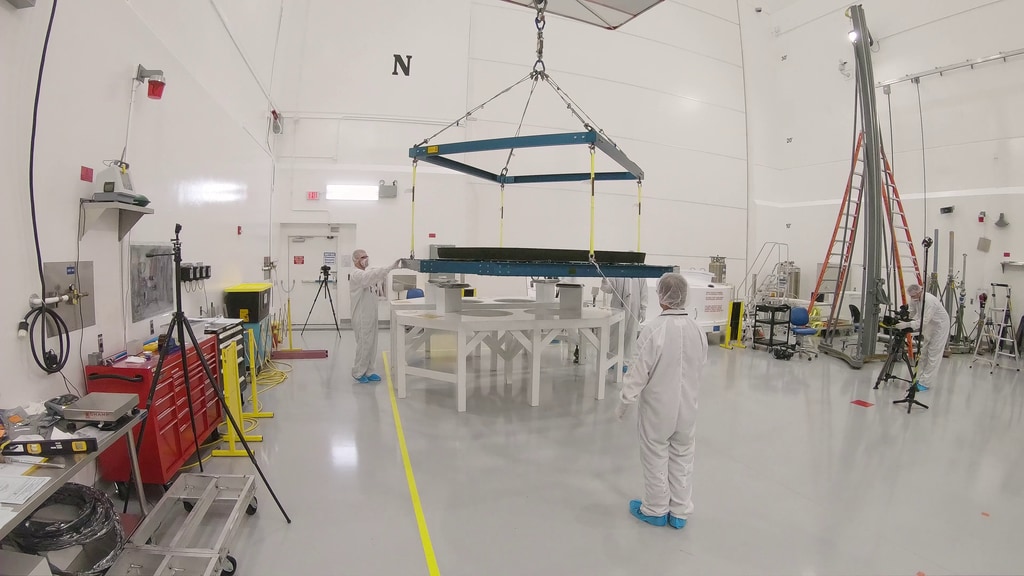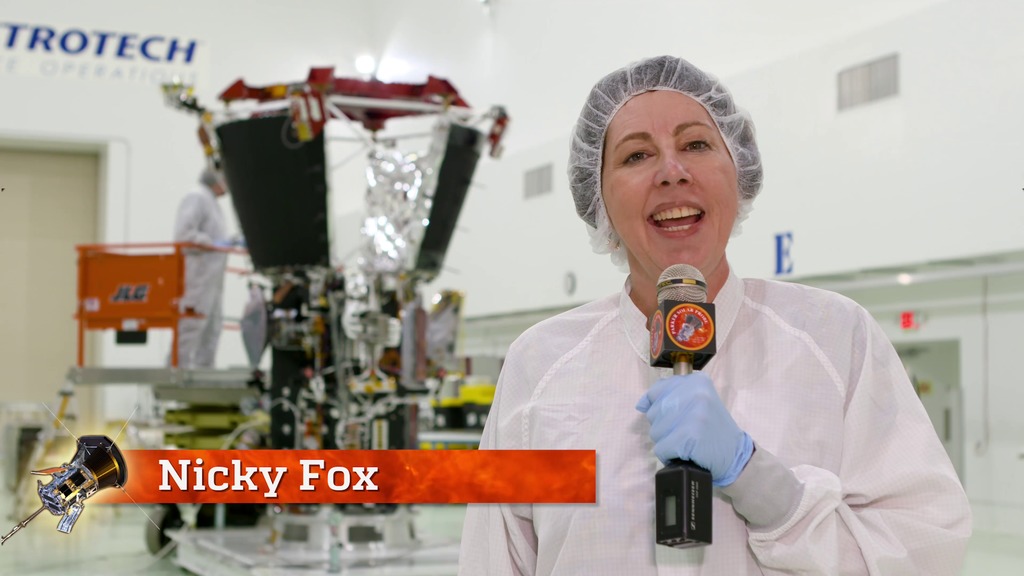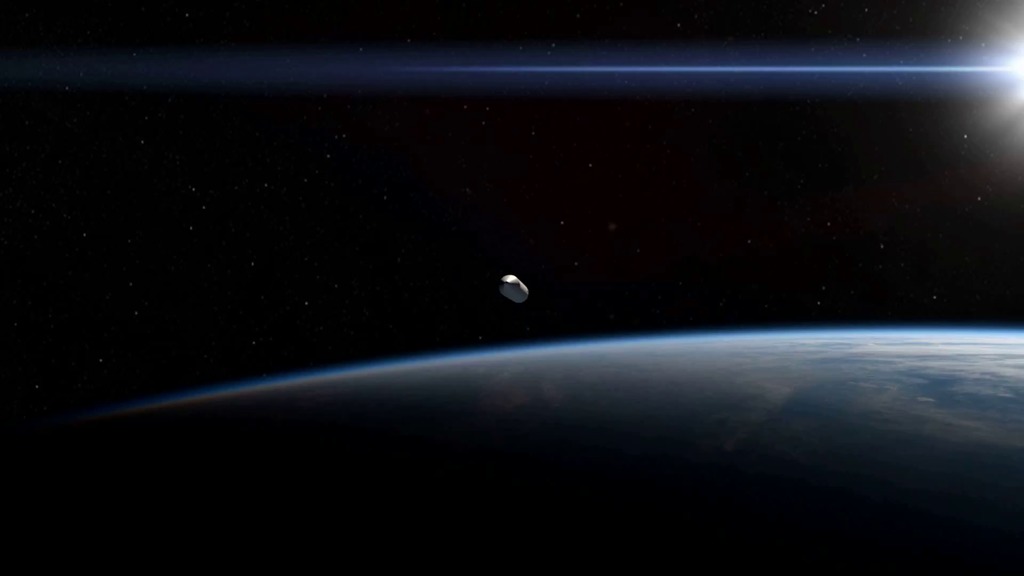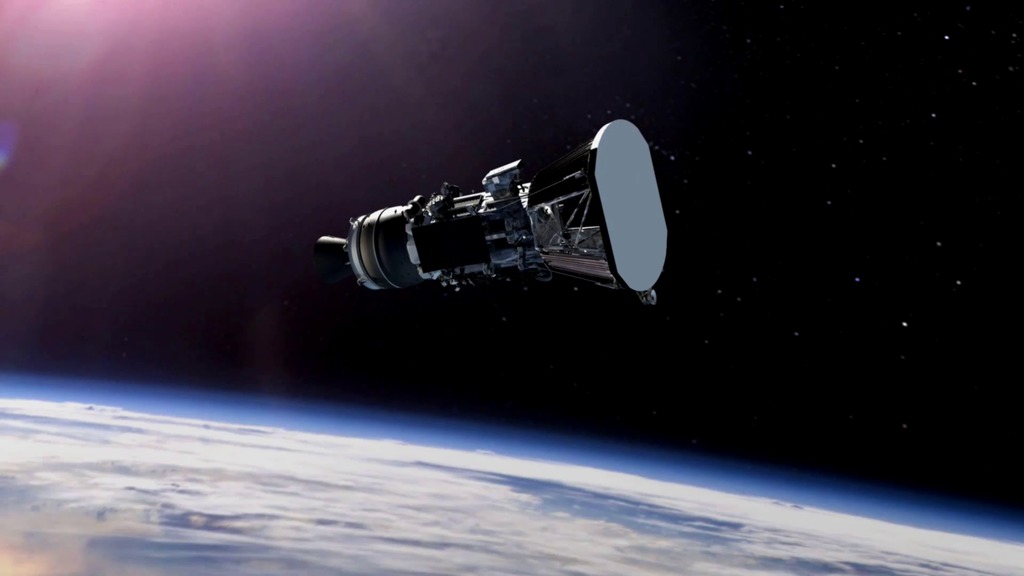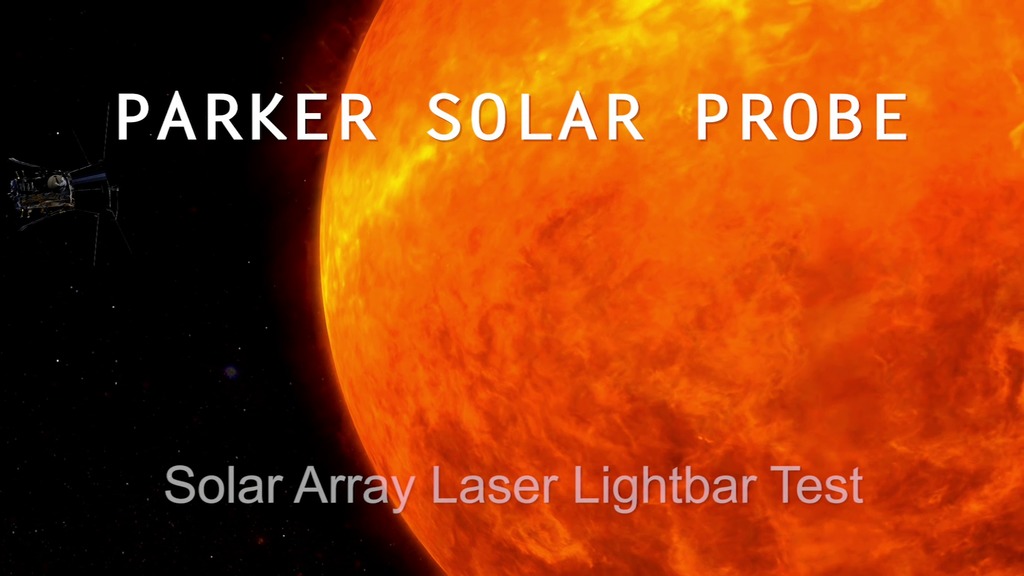Parker Solar Probe: Testing and Integration
Main flight harness installation.
Credit: NASA/JHUAPL
Top deck cooling system installation.
Credit: NASA/JHUAPL
As the team readies the spacecraft for launch, blanketing and harness work continues.
Credit: NASA/JHUAPL
Parker Solar Probe continues to be prepared for launch with actuator testing and blanketing.
Credit: NASA/JHUAPL
Busy week with fit checks as well as a light bar test as the spacecraft prepares for launch in 2018.
Credit: NASA/JHUAPL
A time-lapse capturing Parker Solar Probe being transported from Johns Hopkins Applied Physics Laboratory to NASA's Goddard Space Flight Center for further testing in November 2017.
Watch this video on the NASA.gov Video YouTube channel.
Parker Solar Probe's heat shield recently moved from the Johns Hopkins Applied Physics Lab, or APL, in Laurel, Maryland, to NASA's Goddard Space Flight Center in Greenbelt to undergo testing in the Thermal Vacuum Chamber, which will simulate the variable space conditions that the heat shield must endure during the mission.
Credit: NASA/Johns Hopkins APL/Lee Hobson
Watch this video on the Johns Hopkins APL YouTube channel.

The Parker Solar Probe team at Johns Hopkins APL prepares to lift the heat shield, called the Thermal Protection System, in preparation for shipment to NASA's Goddard Space Flight Center for further environmental testing on Dec. 6, 2017.
Credit: NASA/Johns Hopkins APL/Ed Whitman

Parker Solar Probe’s Thermal Protection System, or heat shield, is carefully moved to a shipping container for transport from Johns Hopkins APL to NASA's Goddard Space Flight Center for further environmental testing on Dec. 6, 2017.
Credit: NASA/Johns Hopkins APL/Ed Whitman

The Parker Solar Probe team carefully lowers the spacecraft's Thermal Protection System into a shipping container to carry the heat shield from Johns Hopkins APL to NASA's Goddard Space Flight Center on Dec. 6, 2017.
Credit: NASA/Johns Hopkins APL/Ed Whitman

The structure that holds Parker Solar Probe's Thermal Protection System is lowered into the Thermal Vacuum Chamber at NASA’s Goddard Space Flight Center on Dec. 7, 2017.
Credit: NASA/Johns Hopkins APL/Ed Whitman

Parker Solar Probe's Thermal Protection System is lowered into the Thermal Vacuum Chamber at NASA's Goddard Space Flight Center in preparation for environmental testing on Dec. 7, 2017.
Credit: NASA/Johns Hopkins APL/Ed Whitman

Parker Solar Probe's Thermal Protection System – the heat shield that will protect the spacecraft from the Sun's intense heat – is lowered into the Thermal Vacuum Chamber at NASA's Goddard Space Flight Center in preparation for environmental testing on Dec. 7, 2017.
Credit: NASA/Johns Hopkins APL/Ed Whitman

Member of the NASA Parker Solar Probe team wheel the spacecraft – bagged to protect it from contamination – from its cleanroom at NASA's Goddard Space Flight Center in Greenbelt, Md., to the thermal vacuum chamber, where it will undergo approximately seven weeks of testing at extreme temperatures that will simulate the space environment.
Credit: NASA/JHUAPL/Ed Whitman

Parker Solar Probe is slowly lifted and carried to the top of the thermal vacuum chamber, which will simulate the airless environment of space, in addition to conducting intense hot and cold temperature testing.
Credit: NASA/JHUAPL/Ed Whitman

NASA's Parker Solar Probe descends into the thermal vacuum chamber at NASA's Goddard Space Flight Center. The spacecraft will be inside the chamber for about seven weeks.
Credit: NASA/JHUAPL/Ed Whitman

Engineers and technicians from the Parker Solar Probe team monitor the descent of the spacecraft into the thermal vacuum chamber.
Credit: NASA/JHUAPL/Ed Whitman

Parker Solar Probe team members begin the process of reattaching the spacecraft to power and other systems in preparation for testing the operation of the probe in intense heat and cold while in an airless environment.
Credit: NASA/JHUAPL/Ed Whitman

Members of the Parker Solar Probe team prepare the spacecraft for space environment testing in the thermal vacuum chamber at NASA's Goddard Space Flight Center. The thermal vacuum chamber duplicates the airless environment of space and simulates the cold and hot temperature cycles the spacecraft will endure during its seven-year exploration of the Sun.
Credit: NASA/Johns Hopkins APL/Ed Whitman

To prepare NASA's Parker Solar Probe for space environment testing, the team must make hundreds of connections to allow the engineers and technicians to monitor the safety and performance of the spacecraft's systems. Four hundred thermocouples mounted on the spacecraft let the team track the health of the probe as it undergoes temperature cycling in the thermal vacuum chamber at NASA's Goddard Space Flight Center.
Credit: NASA/Johns Hopkins APL/Ed Whitman

Parker Solar Probe team members from the Johns Hopkins Applied Physics Laboratory work to attach testing and monitoring equipment and sensors to the spacecraft inside the thermal vacuum chamber at NASA's Goddard Space Flight Center. Space environment testing duplicates the airless environment of space and simulates the cold and hot temperature cycles the spacecraft will endure during its seven-year exploration of the Sun.
Credit: NASA/Johns Hopkins APL/Ed Whitman

NASA's Parker Solar Probe sits inside the thermal vacuum chamber at NASA's Goddard Space Flight Center. On Jan. 27, the spacecraft began space environment testing inside the chamber, which simulates the hot and cold airless environments that the mission will experience during its voyage to the Sun.
Credit: NASA/Johns Hopkins APL/Ed Whitman

NASA's Parker Solar Probe sits inside the thermal vacuum chamber at NASA's Goddard Space Flight Center just before the main hatch is closed to begin space environment testing. The thermal vacuum chamber duplicates the airless environment of space and simulates the cold and hot temperature cycles the spacecraft will endure during its seven-year exploration of the Sun.
Credit: NASA/Johns Hopkins APL/Ed Whitman
Parker Solar Probe Enters Thermal Vacuum Chamber at NASA Goddard (B-roll)
On Wednesday, Jan. 17, NASA's Parker Solar Probe was lowered into the 40-foot-tall thermal vacuum chamber at NASA's Goddard Space Flight Center in Greenbelt, Maryland. The spacecraft will remain in the chamber for about seven weeks, coming out in mid-March for final tests and packing before heading to Florida. Parker Solar Probe is scheduled to launch from NASA's Kennedy Space Center on July 31, 2018, on a Delta IV Heavy launch vehicle.
Credit: NASA/Johns Hopkins APL/Lee Hobson
Watch this video on the Johns Hopkins APL YouTube channel.

Members of the Parker Solar Probe team prepare the spacecraft to be lifted from the Space Environment Simulator at NASA’s Goddard Space Flight Center in Greenbelt, Maryland, on March 24, 2018. The spacecraft has spent eight weeks undergoing successful testing in the Space Environment Simulator to ensure that the mission will operate as planned during its seven-year long exploration of the Sun.
Credit: NASA/Johns Hopkins APL/Ed Whitman

NASA’s Parker Solar Probe is carefully lifted from the Space Environment Simulator at NASA’s Goddard Space Flight Center in Greenbelt, Maryland, on March 24, 2018. The probe has spent eight weeks undergoing space environment testing, including hot and cold cycling tests that mimic the temperature changes the spacecraft will experience during its seven-year long exploration of the Sun.
Credit: NASA/Johns Hopkins APL/Ed Whitman

Parker Solar Probe is lifted out of the Space Environment Simulator at NASA’s Goddard Space Flight Center in Greenbelt, Maryland, on March 24, 2018. The spacecraft has spent eight weeks undergoing space environment testing in the thermal vacuum chamber. After about seven more days of testing outside the chamber, Parker Solar Probe will travel to Florida for a scheduled launch on July 31, 2018, from NASA’s Kennedy Space Center.
Credit: NASA/Johns Hopkins APL/Ed Whitman

Members of the Parker Solar Probe team from the Johns Hopkins Applied Physics Lab in Laurel, Maryland, monitor the progress of the spacecraft as it is lifted from the Space Environment Simulator at NASA’s Goddard Space Flight Center in Greenbelt, Maryland, and lowered to the custom platform visible in the foreground. The spacecraft has spent eight weeks undergoing space environment testing in the thermal vacuum chamber before being lifted out on March 24, 2018.
Credit: NASA/Johns Hopkins APL/Ed Whitman

Members of the Parker Solar Probe team from the Johns Hopkins Applied Physics Lab and NASA’s Goddard Space Flight Center carefully lower the spacecraft onto a specially built platform on March 24, 2018. The probe has spent eight weeks undergoing space environment testing, including hot and cold cycling tests that mimic the temperature changes the spacecraft will experience during its seven-year long exploration of the Sun.
Credit: NASA/Johns Hopkins APL/Ed Whitman

Parker Solar Probe team members connect the spacecraft to a specially built platform after removing the probe from the Space Environment Simulator at NASA’s Goddard Space Flight Center in Greenbelt, Maryland, on March 24, 2018. The probe will undergo about seven more days of testing outside the chamber, then travel to Florida for a scheduled launch on July 31, 2018, from NASA’s Kennedy Space Center.
Credit: NASA/Johns Hopkins APL/Ed Whitman

NASA’s Parker Solar Probe is wheeled into a clean room at NASA’s Goddard Space Flight Center in Greenbelt, Maryland, on March 24, 2018, after successfully completing space environment testing to verify the spacecraft is ready for operations in space. The probe will undergo about seven more days of testing outside the chamber, then travel to Florida for a scheduled launch on July 31, 2018, from NASA’s Kennedy Space Center.
Credit: NASA/Johns Hopkins APL/Ed Whitman
Thermal Vacuum Chamber at NASA Goddard Opened (B-roll)
The Space Environment Simulator at NASA Goddard is opened on March 24, 2018, in preparation for the removal of the Parker Solar Probe spacecraft. The spacecraft spent eight weeks undergoing space environment testing in the thermal vacuum chamber. After about seven more days of testing outside the chamber, Parker Solar Probe will travel to Florida for a scheduled launch on July 31, 2018, from NASA’s Kennedy Space Center.
Credit: NASA/Johns Hopkins APL/Lee Hobson
Parker Solar Probe Lifted from Thermal Vacuum Chamber at NASA Goddard (B-roll)
Parker Solar Probe is lifted out of the Space Environment Simulator at NASA Goddard on March 24, 2018. The spacecraft spent eight weeks undergoing space environment testing in the thermal vacuum chamber. After about seven more days of testing outside the chamber, Parker Solar Probe will travel to Florida for a scheduled launch on July 31, 2018, from NASA’s Kennedy Space Center.
Credit: NASA/Johns Hopkins APL/Lee Hobson
WISPR door deployment testing (b-roll)
The door on the WISPR instrument aboard NASA's Parker Solar Probe was tested on October 17, 2017 at the Johns Hopkins Applied Physics Laboratory.
Credit: NASA/Johns Hopkins APL/Lee Hobson
For More Information
Credits
Please give credit for this item to:
The Johns Hopkins University Applied Physics Laboratory
-
Animator
- Steve Gribben (Johns Hopkins University/APL)
-
Videographer
- Lee Hobson (Johns Hopkins University/APL)
-
Photographer
- Ed Whitman (Johns Hopkins University/APL)
-
Support
- Joy Ng (USRA)
- Karen Fox (ADNET Systems, Inc.)
- Genna Duberstein (USRA)
- Sarah Frazier (ADNET Systems, Inc.)
- Kathalina Tran (KBR Wyle Services, LLC)
- Tom Bridgman (Global Science and Technology, Inc.)
Missions
This page is related to the following missions:Release date
This page was originally published on Friday, September 22, 2017.
This page was last updated on Wednesday, May 3, 2023 at 1:47 PM EDT.
